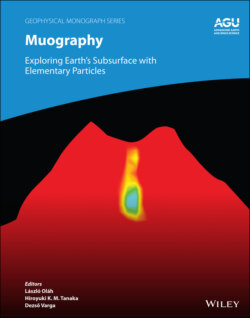Читать книгу Muography - Группа авторов - Страница 27
1.3.1 Early Works
ОглавлениеIn the early stage of cosmic ray studies, underground measurements were the most effective way to extend the energy range of the measured muon spectrum beyond 1 TeV. In these measurements, mine galleries located at various depths were utilized to measure the depth‐dependent muon flux since geological features of these mines were well studied. Inversely, if this depth‐dependent muon flux was used as a reference curve, the average density above the detector could be derived. The idea of using muons produced by cosmic rays as probes was first applied 75 years ago by E.P. George, who measured the thickness of the rock overburden above a tunnel of the hydroelectric plant in Snowy Mountain, Australia (George, 1955). George measured the reduction in the muon flux after passing through the rock. The apparatus consisted of Geiger counters but was unable to provide an image of any structure within the overlying rock.
The use of muography to reveal the internal structures of inaccessible objects in archeology was introduced in the late 1960s by a group led by Luis Alvarez to search for undiscovered chambers in the Pyramid of Chephern in Egypt (Alvarez et al., 1970). After the invention of a spark chamber with a digital readout, imaging became more realistic. The group recorded the trajectories of muons through the pyramid and studied their transmission to establish why the Pyramid of Chephren had only one burial chamber (the so‐called Belzoni chamber) while the pyramid made by his father Cheops had more complicated internal structures, including the King's and Queen's chambers and the Grand Gallery. This joint project between the United States and the United Arab Republic began in 1966. Calculations showed that if a hidden room was located above the Belzoni chamber, it could be observed in the same way that a void is highlighted by a darker area in an X‐ray image. However, no hidden rooms were found inside the pyramid. Instead, the group showed the potential of the technique by detecting the cap rock from the Belzoni chamber. This pioneering work paved the way for the application of muography in various fields.
Since TeV muons penetrate kilometric rock, the technique shown by Alvarez et al. (1970) was in principle applicable to mountains. This possibility was explored by focusing on detecting muons that traversed at angles almost parallel to the ground surface, which could be utilized to probe mountains by tracing the trajectories of muons emerging from the other side of the mountain (Nagamine et al., 1995). Muography cannot image the deep structure of a volcano such as the magma chamber; however, it can image shallow regions of the volcano, which can provide useful information for understanding how the eruption style might change. The first muographic image of the inside of a volcano suggested possible pathways for magma ejection by visualizing the shape and size of low‐density regions under a deposit of solidified magma (Tanaka et al., 2007). At the same time, the results showed visual evidence of the resolving power of muography, and its applicability to any targets smaller than volcanoes. The first time‐sequential muographic images that captured the motion of subterranean geofluid targeted the rainfall‐triggered permeation of water into the mechanical fracture zone of the active seismic fault (Tanaka et al., 2011). The results later motivated researchers to apply muography to monitoring underground water conditions (Tanaka & Sannomiya, 2012) and magmatic motion inside volcanoes (Oláh et al., 2019; Tanaka et al., 2014).
